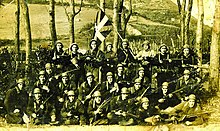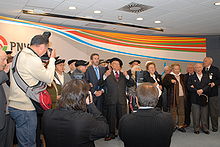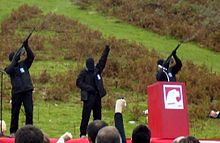This article has multiple issues. Please help
improve it or discuss these issues on the
talk page. (
Learn how and when to remove these template messages)
.mw-parser-output .hidden-begin{box-sizing:border-box;width:100%;padding:5px;border:none;font-size:95%}.mw-parser-output .hidden-title{font-weight:bold;line-height:1.6;text-align:left}.mw-parser-output .hidden-content{text-align:left}You can help expand this article with text translated from
the corresponding article in Basque. (June 2022) Click [show] for important translation instructions.
View a machine-translated version of the Basque article.
Machine translation, like
DeepL or
Google Translate, is a useful starting point for translations, but translators must revise errors as necessary and confirm that the translation is accurate, rather than simply copy-pasting machine-translated text into the English Wikipedia.
Do not translate text that appears unreliable or low-quality. If possible, verify the text with references provided in the foreign-language article.
You must provide
copyright attribution in the
edit summary accompanying your translation by providing an
interlanguage link to the source of your translation. A model attribution edit summary is Content in this edit is translated from the existing Basque Wikipedia article at [[:eu:Eusko Gudarostea]]; see its history for attribution.
You should also add the template ((Translated|eu|Eusko Gudarostea)) to the
talk page.
For more guidance, see
Wikipedia:Translation.
You can help expand this article with text translated from
the corresponding article in Catalan. (June 2022) Click [show] for important translation instructions.
View a machine-translated version of the Catalan article.
Machine translation, like
DeepL or
Google Translate, is a useful starting point for translations, but translators must revise errors as necessary and confirm that the translation is accurate, rather than simply copy-pasting machine-translated text into the English Wikipedia.
Do not translate text that appears unreliable or low-quality. If possible, verify the text with references provided in the foreign-language article.
You must provide
copyright attribution in the
edit summary accompanying your translation by providing an
interlanguage link to the source of your translation. A model attribution edit summary is Content in this edit is translated from the existing Catalan Wikipedia article at [[:ca:Eusko Gudarostea]]; see its history for attribution.
You should also add the template ((Translated|ca|Eusko Gudarostea)) to the
talk page.
For more guidance, see
Wikipedia:Translation.
You can help expand this article with text translated from
the corresponding article in Spanish. (June 2022) Click [show] for important translation instructions.
View a machine-translated version of the Spanish article.
Machine translation, like
DeepL or
Google Translate, is a useful starting point for translations, but translators must revise errors as necessary and confirm that the translation is accurate, rather than simply copy-pasting machine-translated text into the English Wikipedia.
Consider
adding a topic to this template: there are already 5,275 articles in the
main category, and specifying|topic= will aid in categorization.
Do not translate text that appears unreliable or low-quality. If possible, verify the text with references provided in the foreign-language article.
You must provide
copyright attribution in the
edit summary accompanying your translation by providing an
interlanguage link to the source of your translation. A model attribution edit summary is Content in this edit is translated from the existing Spanish Wikipedia article at [[:es:Euzko Gudarostea]]; see its history for attribution.
You should also add the template ((Translated|es|Euzko Gudarostea)) to the
talk page.
For more guidance, see
Wikipedia:Translation.
(
Learn how and when to remove this template message)


